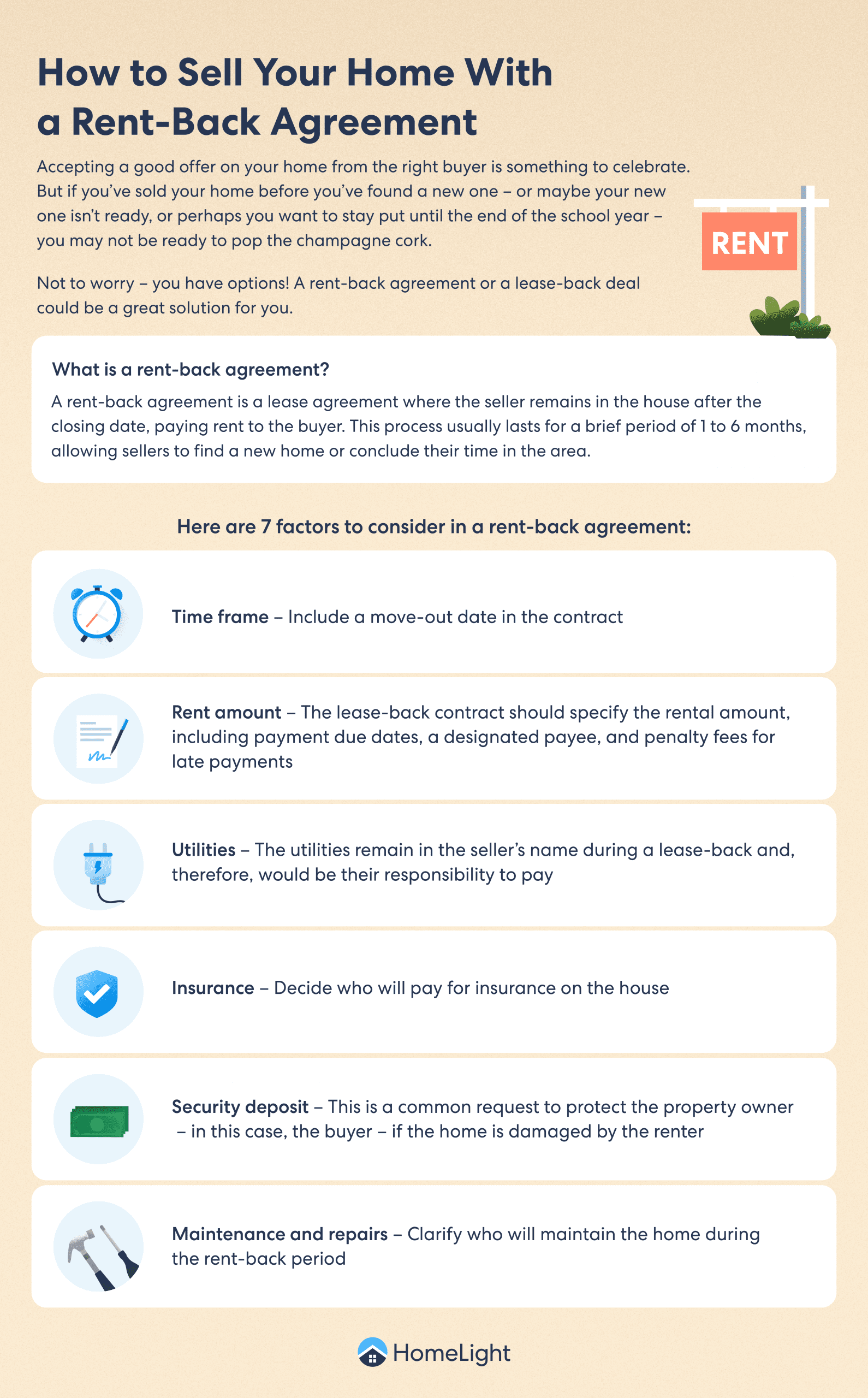

Lori Lovely edited the Real Estate Home section for the Indianapolis Star and covered the annual Dream Home construction and decor for Indianapolis Monthly magazine. She has written guides for selling houses and more.
Richard Haddad , Executive Editor Richard Haddad Executive EditorRichard Haddad is the executive editor of HomeLight.com. He works with an experienced content team that oversees the company’s blog featuring in-depth articles about the home buying and selling process, homeownership news, home care and design tips, and related real estate trends. Previously, he served as an editor and content producer for World Company, Gannett, and Western News & Info, where he also served as news director and director of internet operations.
Accepting a good offer on your home from the right buyer should be celebrated. But if you’ve sold your home before you’ve found a new one – or maybe your new one isn’t ready, or perhaps you want to stay put until the end of the school year – you may not be ready to pop the champagne cork.
Don’t panic. You have options, such as a rent-back agreement, also known as a lease-back deal, that would allow you to stay in the home you just sold a bit longer to give you time to find a new place, to wait for the next home to be built, or to let your children finish the school year.
If you’re selling your home and considering the benefits of a rent-back agreement with the buyer, partner with a top agent in your market who has the experience to make it happen.
Read on for some of the benefits and drawbacks of a rent-back agreement, as well as some advice on how to protect yourself if you decide to go this route.
In this scenario, the buyer agrees to rent back the home to the seller for an agreed-upon amount of time (typically, no more than 60 days) after closing. It can be mutually beneficial, saving the seller from the additional expense and inconvenience of moving twice, and providing a little cash inflow for the buyer.
When a seller isn’t ready to move – for whatever reason – Joel Barber, a top South Carolina real estate agent who works with 83% more single-family homes than average agents in his Myrtle Beach market, says the “best solution is for the seller to stay in the home up to six months with a ‘possession after closing’ option.” He refers to such an option as “flipping the buyer contingency,” but it’s also commonly known as a rent-back.
Some mortgage lenders require the buyer to occupy the home within 60 days, which we’ll address in our “seven factors to consider” section below.


If you need time to find a new place to live or time to arrange a move, you may be interested in a rent-back agreement. Of course, it’s not all up to you; the buyer has to concur. Here are some things to consider as you initiate a rent-back agreement:
It might not be easy to convince a buyer to agree to a rent-back deal. Many are eager to move into their new home. Some are reluctant to become a landlord, even for the short duration of a lease-back situation.
According to Barber, it can depend on the housing market in your area. “As the market changes, fewer buyers are willing to rent back.”
Regardless of the market, a buyer might offer free rent-back as a way to enhance their purchase offer and give them an advantage over the competition.


If the buyer is willing to rent your home back to you, be sure to draw up a contract – a Seller’s Post-Settlement Occupancy Agreement or a Seller License to Remain in Possession Addendum. Each has differences, but whichever you choose, it should include the rent amount, a security deposit (to be held by the buyer in case of damages), an agreed-upon move-out date, insurance requirement, and an agreement about whose responsibility it is to maintain the home and address any emergency repairs.
The seller may ask to include an early move-out clause that would return a prorated amount of the rent – or, alternatively, the option to extend the rent-back period.
Forms and tenancy laws vary by state. Many Realtor associations offer state-specific rent-back agreements to member agents. California, for example, requires a residential lease agreement for rent-backs that exceed 29 days. Consult with your real estate agent or real estate attorney.


 A house you can rent." width="192" height="108" />
A house you can rent." width="192" height="108" />
A rent-back arrangement may not be for everyone. Here’s a short list of pros and cons to help you determine if it’s right for you (and your buyer).
Barber says the primary advantage is budgeting. “The main benefit is that the seller closes on the property, so [they] have the proceeds from the sale to buy a new home.”
Another money-saving upside of a lease-back deal for a seller is that it can mean one less move. Instead of having to put furniture in storage and find a short-term rental until a new house is found or made ready, the seller stays put, saving time and money. With rental prices up about 3.3% over last year, the savings could be significant.
For a buyer, it means a little extra income, which can be particularly beneficial in a seller’s market when housing prices are high. Buyers can even ask for an additional cost-per-day or raise the rates on an extension if the seller doesn’t move out by the agreed-upon date.
A seller remaining in the home after closing on a rent-back agreement will have to make arrangements for renters’ insurance because liability is often the biggest point of contention. It’s wise to have a contingency plan if move-out is delayed because the buyer may not agree to an extension or may raise the rate significantly.
Buyers will have to wait an extended amount of time to move in or at least take possession and begin remodeling if they agree to a rent-back period. This could get complicated if they have sold a home or their lease is up. If the seller refuses to leave, the buyer will have to start the eviction process, which usually includes going to court and can get costly.
The buyer may not want to be a landlord who has to deal with cleaning up after the seller or collecting rent.
Get a near-instant real estate house price estimate from HomeLight for free. Our tool analyzes the records of recently sold homes near you, your home’s last sale price, and other market trends to provide a preliminary range of value in under two minutes.
When weighing the pros and cons of a rent-back situation, try to imagine every possible aspect of the agreement. Here are a few things to keep in mind:
1. Time frame: You’ll want to include a move-out date in your contract. If you’re just waiting on an impending closing date, it should be easy to determine how long you’ll be staying in the house. However, if you’re waiting on construction or renovation, or if you haven’t even found a new house yet, the timeline can get a bit vague. Thus, it’s wise to include a clause in the contract allowing for an extension should the need arise. Be aware that some buyers won’t agree to that, so you may still have to make a temporary move.
Keep in mind that if your buyer purchases your home with a mortgage loan, the lender may impose occupancy restrictions. If the lender requires the buyer to occupy the home, the buyer typically has up to 60 days to move in. Thus, the occupancy requirement could limit the number of days your buyer agrees to rent back the house.
Alternatively, if the rent-back period is more than 60 days, the lender may consider the home an investment property rather than a primary residence, and that can carry different requirements and limitations. You may be in a tenancy situation.
2. Rent amount: The lease-back contract should specify the rental amount.
Some buyers calculate the per diem cost of their mortgage and property tax, then multiply that dollar amount by the number of days you occupy the home to come up with a figure. Others will want to use market value, or an amount that similar homes in the area rent for, as a basis for rental fees.
“Get [the rent] for as little as you can,” suggests Anne Sena, who has a combined 25 years of real estate experience in New York and Tennessee. But if your home is in a seller’s market, that might not be so easy.
Barber explains that despite changing market conditions, inventory is still tight, which means that “the rental market is stronger than the housing market,” so buyers can effectively “name their price” – and get it.
The rent-back agreement should also include these payment details:
A seller might ask for a pro-rated refund as an incentive for moving out before the scheduled date.


3. Utilities: Typically, the utilities remain in the seller’s name during a lease-back, and, therefore, would be their responsibility to pay. It’s wise to include this in the contract, along with specifying that utilities will be transferred out of the seller’s name when the buyer takes possession.
4. Insurance: Decide who is going to pay for insurance on the house. Sometimes, the seller will get renter’s insurance, but other times, the buyer will insure the house they’ve just purchased. Even if the buyer insures the house, the seller should consider renter’s insurance in the event of loss or damage.
5. Security deposit: As with any rental agreement, a security deposit is a common request to protect the property owner — in this case, the buyer — in case the home is damaged by the renter. In a lease-back arrangement, Sena says that the parties typically hold the funds in an escrow account. The buyer will conduct a final walkthrough at the end of the seller’s occupancy before releasing the security deposit back to the seller.
6. Maintenance and repairs: While the buyer often shoulders this responsibility, it’s smart to clarify who will maintain the home during the rent-back period. That includes lawn care.
Repairs are more complicated. If the water heater stops working after the sale closes and the seller is occupying the property, who pays to fix it? In many residential lease situations, the owner is ultimately responsible for such repairs. But in a rent-back situation, your agreement may stipulate that you agree to return the home in the same condition as you took possession, which could place the responsibility on you. Study your rent-back agreement closely and understand your potential liability for unexpected home repairs before signing.
7. Owner access: The buyer may want to access the property during the lease-back period in order to make plans for renovations or remodeling. It could be as simple as measuring for new drapes or more involved, with a contractor in tow. Either way, the seller (now tenant) has a right to expect appointments to be scheduled at reasonable hours, typically with at least 24- to 48-hour notice. The safest way to avoid any issues is to specify the terms in writing.
Whatever a seller’s reason to delay a move after a home sale, negotiating a rent-back can provide several benefits – among them, the potential erasure of the need to move twice and related cost savings.
Buyers can also benefit from leasing their newly purchased home back to the seller. Doing so can alleviate some of the purchase pain when housing prices remain high, and inventory is tight. Agreeing to a rent-back can give a buyer’s bid an advantage.
Flexibility can benefit everyone, but both sides should carefully spell out the terms of the rent-back in a legally binding contract. It’s best to partner with a top real estate agent and consult a qualified attorney to protect yourself during rent-back agreement negotiations.
Sena advises sellers not to be shy about asking for what they want. “Write your contract exactly the way you need it to be,” she says.
Header Image Source: (Alex Tan / Death to the Stock Photo)